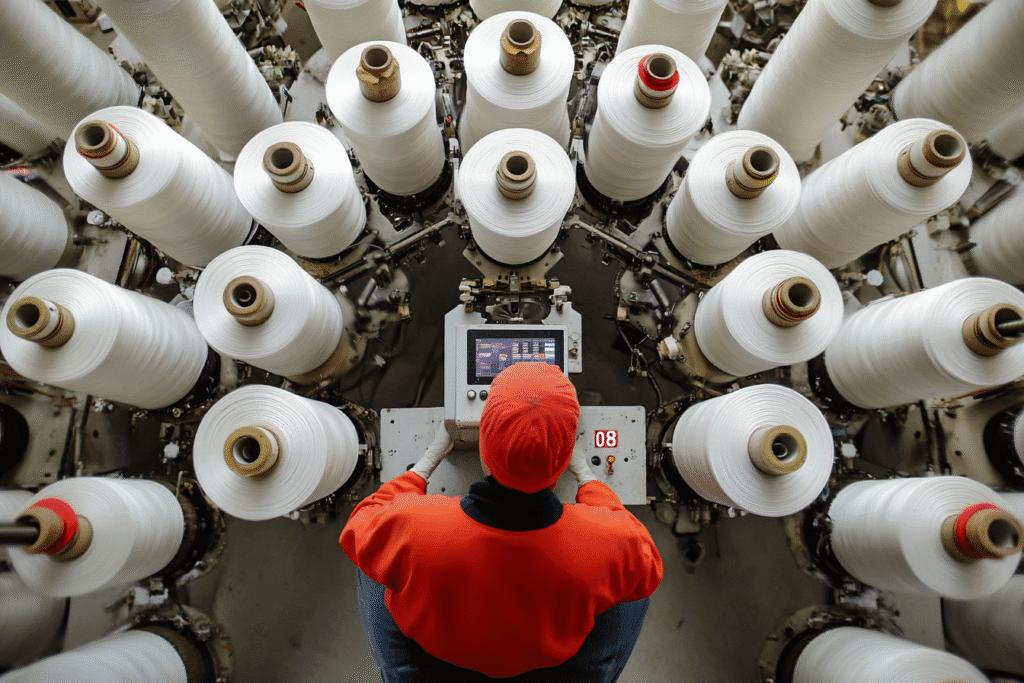
Understanding Spandex Ratios in Fabric Blends
Spandex (also called elastane or Lycra®) is a synthetic fiber known for its exceptional elasticity—it can stretch 500-800% of its original length and recover. The spandex ratio in fabric blends determines critical performance factors like stretch, recovery, durability, and comfort.
What is Spandex and Why Does Ratio Matter?
Key Properties of Spandex:
- Ultra-Elastic: Provides stretch without losing shape.
- Lightweight: Adds minimal bulk to fabrics.
- Moisture-Wicking: Often blended with synthetics like nylon for activewear.
- Heat-Sensitive: Melts at high temperatures (avoid high-heat ironing).
Why Ratio Matters:
- Too Little Spandex (<5%): Limited stretch, prone to bagging (e.g., cheap leggings).
- Too Much Spandex (>30%): Overly compressive, reduces breathability (e.g., medical compression gear).
- Sweet Spot: Varies by garment type (e.g., 10-15% for swimwear, 5-10% for jeans).
Example:
A legging with 15% spandex offers better squat-proof recovery than one with 5% spandex.
Common Spandex Blends and Their Applications
- Nylon/Spandex
- Typical Ratio: 80% nylon / 20% spandex
- Best For: Swimwear, activewear (high stretch, chlorine/abrasion resistance).
- Why? Nylon adds durability; spandex ensures flexibility.
- Polyester/Spandex
- Typical Ratio: 85% polyester / 15% spandex
- Best For: Athletic wear, shapewear (moisture-wicking, affordable).
- Trade-off: Less soft than nylon but more cost-effective.
- Cotton/Spandex
- Typical Ratio: 95% cotton / 5% spandex
- Best For: T-shirts, jeans (subtle stretch, breathability).
- Limitation: Loses elasticity faster than synthetic blends.
- Wool/Spandex
- Typical Ratio: 90% wool / 10% spandex
- Best For: Winter activewear (warmth + stretch).
Blend Comparison Table:
| Blend | Spandex % | Pros | Cons |
|---|---|---|---|
| Nylon/Spandex | 10-20% | Durable, chlorine-resistant | Expensive |
| Polyester/Spandex | 10-15% | Affordable, quick-drying | Less breathable |
| Cotton/Spandex | 2-5% | Soft, natural feel | Weak recovery over time |
Key Takeaway:
The ideal spandex ratio depends on the garment’s function. Activewear needs higher spandex (15-20%) for stretch, while casual wear thrives with lower ratios (2-5%). Always prioritize fabric testing before bulk orders.
Spandex Ratio Guidelines by Garment Type
The right spandex percentage makes or breaks a garment’s performance. Here’s a detailed breakdown by category:
Activewear (5-20% Spandex)
Examples: Yoga pants, running tights, sports bras
Key Considerations:
- 5-10% Spandex:
- Basic leggings (moderate stretch)
- Compromise between comfort and cost
- 15-20% Spandex:
- High-performance compression wear
- Squat-proof leggings with muscle support
- 4-way stretch for full range of motion
Pro Tip: For high-intensity workouts, prioritize nylon-spandex blends (e.g., 80/20) over polyester for better recovery.
Swimwear (10-20% Spandex)
Examples: Bikinis, one-pieces, swim shorts
Why Higher Spandex?
- Chlorine/Saltwater Resistance: Spandex fibers wrapped in nylon resist degradation.
- Shape Retention: Prevents sagging when wet (critical for form-fitting suits).
- UPF Protection: Tighter knits block more UV rays.
Blend Advice:
- Competitive Swimwear: 15-20% spandex (e.g., 80% nylon/20% spandex)
- Fashion Swimwear: 10-15% (prioritizes drape over compression)
Red Flag: Swimsuits with <10% spandex lose shape quickly.
Everyday Apparel (2-10% Spandex)
Examples: Jeans, t-shirts, dresses
Ratio Rules:
- Denim (2-5% Spandex):
- Adds comfort without distorting fit (e.g., “stretch jeans”)
- Over 5% causes knee bagging
- Knit Tops (5-10% Spandex):
- Subtle stretch for movement (e.g., fitted tees)
- Cotton-spandex blends (95/5) avoid stiffness
Consumer Hack: For office wear, 3-5% spandex maintains structure while allowing sitting comfort.
Shapewear/Compression Wear (15-30% Spandex)
Examples: Waist trainers, medical compression stockings
Why Extreme Stretch?
- 15-20%: Everyday shaping (e.g., smoothing bodysuits)
- 25-30%: Medical-grade compression (e.g., post-surgery garments)
Fabric Notes:
- Double-layered knits enhance compression
- Polyester-spandex blends dominate (cheaper than nylon)
Caution: >25% spandex may feel restrictive for all-day wear.
Key Takeaways:
- Match spandex % to garment demands (e.g., 20% for swimsuits, 5% for jeans).
- Blend choice matters: Nylon for durability, polyester for affordability.
- Test recovery—high spandex shouldn’t mean permanent stretching.
Factors Influencing Spandex Ratio Selection
Choosing the right spandex percentage isn’t just about garment type—it requires balancing performance needs with fabric engineering principles. Here’s what professionals consider when formulating blends.
Desired Stretch Level (2-Way vs. 4-Way Stretch)
2-Way Stretch (5-10% Spandex)
- Stretches in one direction (usually widthwise)
- Best for: Denim, structured jackets
- Pros: Maintains garment shape
- Cons: Limits mobility (e.g., jeans with 2% spandex feel “stiff” compared to jeggings)
4-Way Stretch (10-25% Spandex)
- Stretches width + length (critical for activewear)
- Best for: Leggings, swimwear, compression gear
- Pros: Full range of motion
- Cons: Higher spandex = faster fiber fatigue if not properly engineered
Technical Insight:
4-way stretch requires special knitting techniques (e.g., circular knits with spandex core-wrapping).
Durability vs. Flexibility Trade-offs
High Spandex (15-30%)
- Flexibility: Excellent for contoured fits (e.g., dancewear)
- Durability Risks:
- Spandex fibers break down with heat/chlorine
- Requires nylon/polyester “sheathing” for protection
Low Spandex (2-5%)
- Durability: Resists pilling, abrasion (e.g., workwear)
- Flexibility Limits: Can feel restrictive
Sweet Spot by Use Case:
| Application | Ideal Spandex % | Durability Hack |
|---|---|---|
| Cycling Shorts | 15-18% | Nylon outer layer prevents chafing |
| Yoga Pants | 12-15% | Brushed interior reduces pilling |
| T-Shirts | 3-5% | Ring-spun cotton blends last longer |
Fabric Weight (GSM) and Spandex Relationship
Lightweight Fabrics (<150 GSM)
- Example: Sheer stockings, summer activewear
- Spandex Rule: Higher % (15-20%) needed to prevent tearing
- Challenge: Too much spandex makes fabric clingy
Midweight Fabrics (150-250 GSM)
- Example: Everyday leggings, t-shirts
- Spandex Rule: 8-12% balances stretch/recovery
- Pro Tip: 200 GSM with 10% spandex = ideal yoga pant weight
Heavyweight Fabrics (>250 GSM)
- Example: Winter compression wear, upholstery
- Spandex Rule: Lower % (5-8%)—fabric weight provides natural resistance
- Exception: Shapewear uses 20%+ despite weight for compression
Key Takeaways:
GSM dictates spandex needs—light fabrics require reinforcement, heavy fabrics need less.
4-way stretch demands higher spandex but requires quality yarns to avoid overstretching.
Durability isn’t just about spandex %—fiber quality and knit structure matter equally.
Testing and Validating Spandex Ratios
Accurately verifying spandex content ensures quality control and prevents supplier fraud. Here’s how professionals confirm ratios through lab and field methods.
Lab Testing Methods
1. Chemical Dissolution (ASTM D629 / ISO 1833)
- Process:
- Sample fabric is immersed in dimethylformamide (DMF) solution
- Dissolves spandex, leaving nylon/polyester/cotton intact
- Remaining fibers are weighed to calculate exact ratios
- Accuracy: ±1% margin of error
- Best for: Bulk order validation, contract disputes
2. Fourier-Transform Infrared Spectroscopy (FTIR)
- How it works:
- Infrared light identifies molecular bonds in fibers
- Creates unique “fingerprint” for spandex vs. other materials
- Advantages:
- Non-destructive testing
- Detects adulterated blends (e.g., polyester falsely labeled as nylon)
3. Microscopic Fiber Analysis
- Method:
- Cross-section view shows spandex (rubbery core) wrapped in other fibers
- Measures filament thickness/distribution
- Reveals:
- Uneven blending (poor quality control)
- Fake “high-spandex” claims where fibers are clustered
Lab Report Checklist:
✔ Request test certificates from ISO 17025-accredited labs
✔ Verify both fiber content and elasticity modulus
Simple Field Tests
1. Burn Test (Quick Material ID)
- Spandex:
- Burns quickly with chemical smell
- Leaves sticky black residue
- Nylon:
- Melts slowly, smells like celery
- Forms hard gray bead
- Polyester:
- Shrinks from flame, sweet odor
- Hard black residue
Limitations: Only confirms presence, not exact percentages
2. Stretch Recovery Check
- Step 1: Mark 10 cm section on fabric
- Step 2: Stretch to 15 cm (50% elongation), hold 30 sec
- Pass Criteria:
- Returns to ≤10.5 cm (≥90% recovery)
- No visible thinning or distortion
3. Swatch Rub Test
- Pilling Test: Rub fabric against itself 50x under pressure
- Poor blends show fuzz/pills immediately
- Color Transfer: Rub with white cloth when wet
- Dye bleeding indicates low-quality dyeing
Key Takeaways:
- Labs provide exact ratios but require time/cost (ideal for bulk orders)
- Field tests spot-check quality during sourcing trips or sampling
- Always cross-verify – suppliers may “enhance” small samples but cut corners in production
Red Flags:
- Supplier refuses to provide testable swatches
- Burn test results don’t match claimed materials
- Stretch recovery <80% after 3 test cycles
Pro Tip: For new suppliers, conduct both lab and field tests on initial shipments to establish baseline quality.
Conclusion: Finding Your Perfect Balance
Selecting the ideal spandex ratio is both a science and an art—one that directly impacts your garment’s performance, comfort, and longevity. Let’s consolidate the key insights:
1. Recap Key Spandex Ratios by Garment Type
- 5-20% Activewear → 15-20% for compression leggings, 8-12% for breathable training tops
- 10-20% Swimwear → Chlorine-resistant blends demand higher spandex
- 2-10% Everyday Wear → 5% for “stretch jeans,” 3% for wrinkle-resistant blouses
- 15-30% Shapewear → Medical-grade compression requires up to 30%
2. The Right Ratio Depends on Performance Needs
There’s no universal “best” percentage—only what’s optimal for your design goals:
- Prioritize stretch? Increase spandex (e.g., 4-way stretch athleticwear).
- Need durability? Balance with high-tenacity nylon (e.g., abrasion-resistant backpacks).
- Cost-sensitive? Polyester-spandex blends offer affordability at 10-15%.
3. Prototype Relentlessly
- Test 3-5 blend variations (e.g., 12% vs. 18% spandex in leggings).
- Evaluate:
- Stretch recovery after 50+ wear/wash cycles
- Seam integrity under tension
- Consumer feedback on comfort
4. Demand Transparency from Suppliers
- Always request:
- Third-party test reports (ASTM/ISO for content and stretch)
- Production samples (not just handpicked “perfect” swatches)
- Ethical compliance proof (OEKO-TEX®, REACH)
Final Thought
The difference between a good garment and a great one often lies in these fractional percentage choices. Start with these guidelines, but let real-world testing refine your standards.
